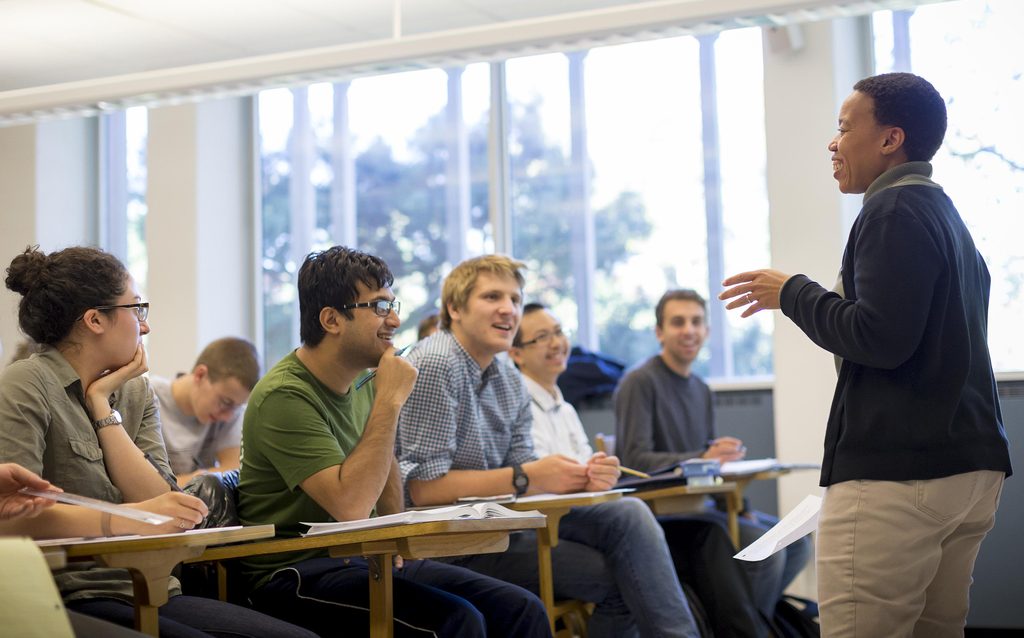The heart of Carleton’s Inclusion, Diversity, and Equity (IDE) plan is a set of five goals.
GOAL 1: Capacity Build the institutional capacity, resources, and dedicated leadership required to engage in the work of inclusion, diversity, and equity (IDE) broadly, including implementing and sustaining the IDE Plan.
This goal is about building our commitment to IDE and the ability to carry out that commitment. We seek to make equity and inclusion a central factor in all of our processes and actions, so that IDE isn’t merely an “add-on” to business as usual, but a catalyst that transforms those processes and actions. There is a great deal of important (and deeply appreciated) IDE work being done on campus already, and we want to ensure that this work remains focused on actions that will improve the experience of living, learning, and working at Carleton. We also want to make sure that we engage the campus community broadly in the work to make our campus equitable and inclusive.
Among the strategies for achieving this goal: Creating an IDE office led by a vice president–level chief diversity officer, developing and implementing ways to audit equity throughout the college, and providing and incentivizing training in equity-minded, inclusive decision making for people who are in leadership positions.
GOAL 2: Representation Significantly increase representation of students, faculty, and staff from underrepresented populations.
We want to make sure that all parts of our community represent the diversity of our nation and world to the greatest extent possible, and the plan seeks ways to make measurable progress toward this goal. The various groups on campus present different challenges and opportunities in this regard. For example, the student population changes more quickly over time than the staff and faculty population. Carleton needs to continue to develop its networks and pipelines in order to recruit and retain a diverse student body, staff, and faculty.
Among the strategies for achieving this goal: Developing early intervention programs that address the satisfaction and academic success of students from underrepresented groups; creating a faculty recruitment strategy based on closer connections with Historically Black Colleges and Universities (HBCUs), Hispanic-Serving Institutions (HSIs), etc., and developing staff recruitment pipelines to Minority Serving Institutions (MSIs), professionals of color associations, etc.
GOAL 3: Resources Establish and sustain the resources and practices necessary to provide an equitable environment for all students, staff, and faculty to thrive.
It’s not enough to increase representation among our faculty, staff, and students. Carleton needs to ensure that everyone who joins our community has the support and access to opportunities they need to thrive and make the most of their time on our campus—inside and outside the classroom. The strategies under this goal seek to identify and remove barriers that result in different outcomes for individuals based on their identity, and to provide support to meet the evolving needs of a diverse community.
Among the strategies for achieving this goal: Developing a comprehensive student-support model, including academic advising, counseling, progress monitoring, etc., ensuring that the Ombuds Program is independent and confidential; and removing barriers to progress through major/minor requirements.
GOAL 4: Engagement Integrate and sustain engagement with the principles of IDE, including the full diversity of perspectives, experiences, and intellectual contributions of historically underrepresented voices.
Goal 4 seeks to make sure we reap all the rewards of an inclusive, diverse, equitable community. The academic enterprise is built to test ideas and points of view both familiar and new. By welcoming contributions from the full range of human experience—especially those from historically underrepresented groups—we can better live up to that ideal and to our mission of creating broadly educated citizens and leaders.
Among the strategies for achieving this goal: Designating IDE-specific development funds for designing or redesigning curriculum; exploring the creation of a Center for Race, Gender, Indigeneity, and Social Justice; hosting facilitated community-wide discussions highlighting underrepresented scholars and community members; and exploring new and enhanced options for recognizing student IDE work.
GOAL 5: Measurable Improvement Demonstrate our commitment to measurable improvement of IDE outcomes (retention, recruitment, achievement, thriving/belonging, and cultural competence) through data collection and analysis and transparent communication.
Our last goal has to do with clarity and accountability. While Carleton has always strived to improve itself and the educational experience it provides, when it comes to inclusion, diversity, and equity, we have lacked consistent measurable goals and the data collection and analysis needed to indicate whether the college is fulfilling its aspirations. By identifying specific outcomes and the offices and leadership positions responsible for achieving those outcomes, we will have a system of measurement and accountability that will show us when and where we’re succeeding and when and where we are not.
Strategies for achieving this goal: Establishing baselines and measures of student, faculty, and staff recruitment, retention, achievement, thriving, belonging, and cultural competence, with special attention to members of underrepresented minorities, first-generation students, and low-income groups; establishing baselines and measures of the effectiveness of programs set up to promote IDE; assigning clear roles in pursuit of the desired outcomes; identifying the group or groups that have responsibility for oversight; and communicating progress in the areas measured.

The Work of the Steering Group | IDE Steering Group | Working Groups | FAQs | Related Efforts